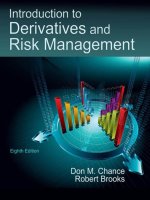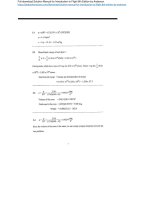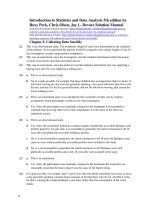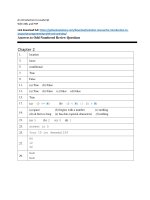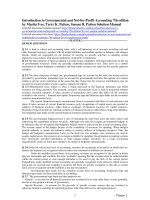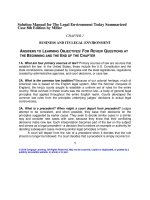Solution manual for introduction to derivatives and risk management 8th edition by chance download
Bạn đang xem bản rút gọn của tài liệu. Xem và tải ngay bản đầy đủ của tài liệu tại đây (138.96 KB, 7 trang )
Solution manual for Introduction to Derivatives and
Risk Management 8th Edition by Chance
CHAPTER 2: STRUCTURE OF OPTIONS MARKETS
END-OF-CHAPTER QUESTIONS AND PROBLEMS
1.
(Option Price Quotations) The option is on AT&T stock. It expires in
January. If it is an exchange-listed option, it expires the Saturday following
the third Friday in January. The option is a call with an exercise price of $65
a share. In other words, the option gives the right to buy AT&T stock at $65
a share up to the expiration day in January.
2.
3.
(Contract Size) a. One contract would now cover 110 shares with an
exercise price of 60/1.10 or 54.55. This would be rounded to the
nearest eighth for 54.50.
b.
Buyers and writers of outstanding contracts are credited with two
contracts for every one previously owned or written. The exercise
price is changed to 12.50. The contract size is still 100.
c.
One contract would now cover 100(4/3) or 133 shares with an
exercise price of 85(3/4) or 63.75. Note: In the context of options, a 4for-3 stock split is the same as a 33 percent stock dividend.
d.
No changes to any contract terms.
(Expiration Dates)
Jan cycle
a.
b.
Feb cycle
Feb, Mar, Apr, Jul Feb, Mar, May, Aug
Jul, Aug, Oct, Jan
Jul, Aug, Nov, Feb
March cycle
Feb, Mar, Jun, Sep
Jul, Aug, Sep, Dec
c.
Dec, Jan, Apr, Jul
Mar, Jun
Dec, Jan, Feb, May
Dec,
Jan,
4.
(Position and Exercise Limits) Short puts and long calls are both strategies
designed to profit in a bullish market. Thus, they are considered to be "on
the same side of the market."
5.
(Option Traders) The market maker is an independent operator whose
objective is to buy options at one price and sell them for a higher price. A
broker is in business to generate commissions on each transaction. A broker
does not have to try to guess where the market is going or whether he can
earn the bid-ask spread.
CBOE rules allow an individual to be both a market maker and a floor
broker but not on the same day. The reason is the potential for a conflict of
interest. For example, suppose a situation arises in which the trader has to
decide whether to execute a personal transaction or a customer transaction.
Whichever transaction is done will bring large profits to the holder of the
position. The trader could obviously be tempted to put personal interests
ahead of the customer's interests. The practice of trading as both a market
maker and a floor broker is called dual trading.
6.
(Order Book Official) Consider a limit order to buy an option at no more
than 3. If there is no offer to sell for 3 or less, the OBO takes the limit order,
adds it to the other limit orders, and makes the highest bids known to the
traders. If any market maker or broker is willing to lower the ask price to 3
or below, the OBO executes the order. Because the price may not fall to 3,
the limit order may never be filled.
7.
(Other Option Trading Systems) In the market maker system, an individual
trader who is not a broker is required to be a market maker. That is, the trader
must be willing to quote a bid and an ask price on certain options. In the
specialist system, there is an individual called the specialist who is charged
with making a market in certain options. In addition, there are registered option
traders who trade on their own but are not required to make a market. The
market maker system puts the role of the specialist and registered option trader
into one person, the market maker. Exchanges using the specialist system claim
that it has the advantage of specialized expertise in keeping the
market fair and orderly. Proponents of the market maker system argue that
because the specialist is a monopolist, the cost to the public is much higher
than under the market maker system, which encourages market makers to
compete with each other for the public's business.
8.
(Mechanics of Trading) Since each contract covers 100 shares, your 20
calls cover 2,000 shares. Thus, your premium is $4,500. You pay your
premium to your broker. Your broker's firm must clear its option trades
through a clearing firm, which is a member of the Options Clearing
Corporation (OCC). Your broker's firm sends the money to the clearing
firm, which deposits it with the OCC. The clearing firm does not actually
have to deposit your money with the OCC. It is allowed to consolidate its
accounts and using a predetermined formula, it deposits the required amount
with the clearinghouse.
9.
(Index Options) If a call stock option is exercised, the writer delivers the
stock to the buyer and receives the exercise price. If a put is exercised, the
buyer delivers the stock to the writer and receives the exercise price. If a call
index option is exercised, the writer pays the buyer the difference between
the stock price and the exercise price. For a put, the writer pays the buyer the
difference between the exercise price and the stock price. The major
advantage of exercising an index option rather than a stock option is not
having to handle the stock. This results in significantly lower transaction
costs.
10.
(Option Price Quotations) Besides the fact that stock and option prices are
already dated by the time they appear in newspapers, these prices are not
synchronized. The prices shown are only the prices of the last trade. The last
trade of the stock may not have taken place at the same time as the last trade
of the option. In addition, the stock and option markets do not even close at
the same time. Moreover, the prices appearing in the newspapers do not
indicate whether the last trade was at a bid price or an ask price. Also,
printed newspapers provide prices for only the most active options (though
more information can usually be obtained from the newspapers’ web sites).
Web sites of the exchanges provide much more current information and in
some cases include information not provided by the newspapers, such as the
bid and ask prices.
11.
(Mechanics of Trading) An option position can be terminated by simply
executing an offsetting order in the market. For example, suppose in January
you bought a Microsoft March 90 call for 5 3/8. In the middle of February it
is selling for 6 1/4 and you would like to take your profit. You simply sell a
Microsoft March 90 call, which offsets your long position. An option can
also be closed by exercising it. You would simply notify your broker that
you want to buy the stock at the exercise price (if a call) or sell it at the
exercise price (if a put). The third way an option position can be terminated
is by expiring out-of-the-money. If it is not advantageous to exercise it by
the expiration, the option simply expires and your position is terminated. In
the over-the-counter market, you can certainly exercise the option or have it
expire out-of-the-money. While you can effectively offset a position by
opening up a new but opposite contract, the procedure is technically
somewhat different than in the exchange-listed options market. In the latter
market, the contracts cancel each other and no further obligation is incurred.
In the over-the-counter market, both contracts remain in force and
consequently each is subject to default on the part of the writer.
12.
(Other Types of Options) Among the option-like instruments are warrants,
convertibles and callable bonds. A warrant is an option offered by the firm
on its own stock. A convertible is a bond or preferred stock that can be
converted into common stock at a fixed rate at the holder's discretion.
Callable bonds are bonds that can be retired early at a specific price at the
discretion of the issuing firm. In addition firms issue options similar to
warrants to executives and employees. Finally, we should note that stock
itself is like a call option held by the stockholders and written by the
bondholders.
13.
(Real Options) Real options are options that corporations hold when they
invest in certain projects and includes options to expand projects, contract
projects, temporarily shut them down, terminate them, or sell them to other
companies. These options do not trade in open markets like exchange-listed
and over-the-counter options, but they possess the characteristics of ordinary
options such as having an exercise price and an expiration.
14.
(Transaction Costs in Option Trading) Floor trading and clearing fees run
from $0.50 to $1.00. These represent the costs of paperwork involved in
processing the trade as well as the exchange's overhead. Commissions,
which reflect the cost of the labor involved in arranging the trade, vary and
depend on the type of broker (discount or full service). The bid-ask spread is
the cost of providing liquidity to the market. The public and floor brokers
representing the public incur all of these costs while market makers incur
floor trading and clearing fees and may incur the bid-ask spread if they have
to deal with other market makers instead of the public.
Transactions in the OTC market do not generally incur commissions and
floor trading and clearing fees. They do incur costs of paperwork and, in
particular, the legal expenses of laying out the rights of each party. Since
transactions in the OTC market are generally executed through dealers, they
incur the dealer's bid-ask spread.
15.
(Over-the-Counter Options Markets) Exchange-traded options are
regulated by the Securities and Exchange Commission. There is essentially
no regulation of OTC option transactions. Firms that trade in the OTC
market, however, are typically regulated by the National Association of
Securities Dealers or, if they are banks, by banking regulators.
APPENDIX 2A QUESTIONS AND PROBLEMS
1.
a.10[0.2($5,000) + $700] = $17,000.
b.
10[0.2($5,000) - ($5,500 - $5,000) + $300] = $8,000. This amount
equals the minimum of 10[$300 + 0.1($5,000)] = $8,000.
c.
10[0.2($5,000) - ($5,000 - $4,500) + $300] = $8,000. This amount
exceeds the minimum of 10[$300 + 0.1($4,500)] = $7,500.
d.
10[0.2($5,000) + $700] = $17,000
e.
The stock price exceeds the exercise price so only 1,000($45)(0.5) or
$22,500 can be borrowed. The call premium, however, can be applied
so the investor must come up with only $27,500 - $7,000 = $20,500.
f.
20($500) = $10,000. One-hundred percent margin must be posted on
all option purchase transactions if the expiration is less than nine
months.
APPENDIX 2B QUESTIONS AND PROBLEMS
1.
2.
3.
a.$450 - $600 = -$150. The $150 loss applies against other taxable income
and reduces taxes by $150(0.28) = $42.
b.
$650 - $600 = $50. The tax is $50(0.28) = $14.
c.
The stock is treated as having been purchased for $25 + $6 = $31. The
taxable gain is $3,500 - $3,100 = $400. The tax is $400(0.28) = $112.
d.
The call would be exercised. You deliver the stock and receive $25
for it. The sale price of the stock for tax purposes is $25 + $6 = $31.
You purchased the stock at $30. The tax is ($3,100 - $3,000)(0.28) =
$28.
e.
The taxable gain is $600 - $350 = $250. The tax is $250(0.28) = $70.
a.Your loss is 100($15 - $12) = $300. This is netted against other gains for a
tax saving of $300(0.31) = $93. The after-tax profit is -$300 + $93 = $207.
b.
You exercise the call and receive 100($441.35 - $425) = $1,635. Your
profit is $1,635 - $1,500 = $135. The tax is $135(0.244) = $32.94. The
after-tax profit is $135 - $32.94 = $102.06.
c.
The call expires worthless. Your loss is $1,500. This is netted against
other gains for tax savings of $1,500(0.31) = $465. The after-tax profit
is -$1,500 + $465 = -$1,035.
d.
Taxes are paid at the end of the year on all trading profits whether the
positions are closed out or not. Thus, in a. and b., if the end of the year
came before you sold or exercised the call, you would owe taxes on any
profits or be able to deduct any losses accumulated up to that time.
a.This would be a wash sale. You replaced the stock with a call option
within the 61-day period. The loss on the stock is not deductible for
tax purposes.
b.
c.
This would be a wash sale because you acquired the call within a 61day period surrounding the sale of the stock. It does not matter that
you acquired the call before you sold the stock.
This is not a wash sale. The wash sale rule pertains only to cases
where the stock is sold at a loss. The rule prohibits deducting the loss.
In this case, the stock was sold at a gain so the wash sale rule has no
effect.

